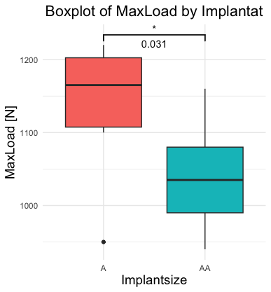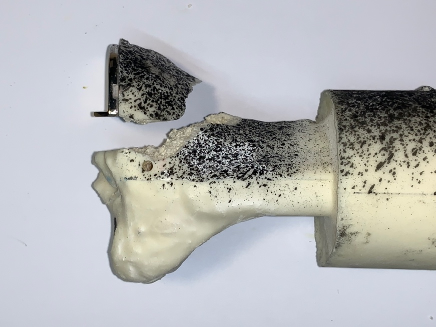German Congress of Orthopaedics and Traumatology (DKOU 2025)
Deutscher Kongress für Orthopädie und Unfallchirurgie 2025 (DKOU 2025)
Does undersizing of the tibial component in unicompartmental knee arthroplasty increase the risk of fracture? A biomechanical study
2Institut für Biomechanik Murnau, Murnau, Deutschland
3BG Unfallklinik Murnau, Murnau, Deutschland
4endogap, Garmisch Partenkirchen, Deutschland
Text
Objectives and questions: Unicompartmental knee arthroplasty (UKA) is a common treatment for medial osteoarthritis, providing faster recovery and better joint kinematics than total knee arthroplasty (TKA). However, periprosthetic tibial plateau fractures (TPF) remain a significant complication. Undersized tibial components, especially size AA, increase TPF risk. This study aims to examine the biomechanical relation between tibial implant size and the risk of periprosthetic fractures.
Material and methods: A biomechanical study was conducted using sixteen customized synthetic bone models to simulate the effects of tibial component sizing in UKA. Proximal tibial models with components of size A and size AA were subjected to axial loading, and the maximum load to failure and cycles to failure were measured for each size. Additionally, plastic axial deformation was calculated at the maximum load level of the weakest construct. Strain patterns were compared with clinically observed fracture lines reported in previous studies.
Results: Size AA had a significantly lower maximum load to failure compared to size A (1,039 N ± 75 N vs, 1,140 N ± 83 N vs., p = 0.031). The strain patterns were consistent with those observed in clinical studies, showing a wedge-shaped distribution from the posteromedial to the anteromedial tibial plateau. Plastic deformation was less than 0.6 mm across all specimens, with no significant difference in axial displacement between the two groups (p = 0.64).
Discussion and conclusion: Undersizing the tibial component, particularly to size AA, reduces load-bearing capacity thereby increases the risk of periprosthetic tibial plateau fractures. Precise implant sizing by correct sagittal resection is essential to minimize the risk of fracture in UKA.
Figure 1 [Abb. 1]
Figure 2 [Abb. 2]
Figure 3 [Abb. 3]







